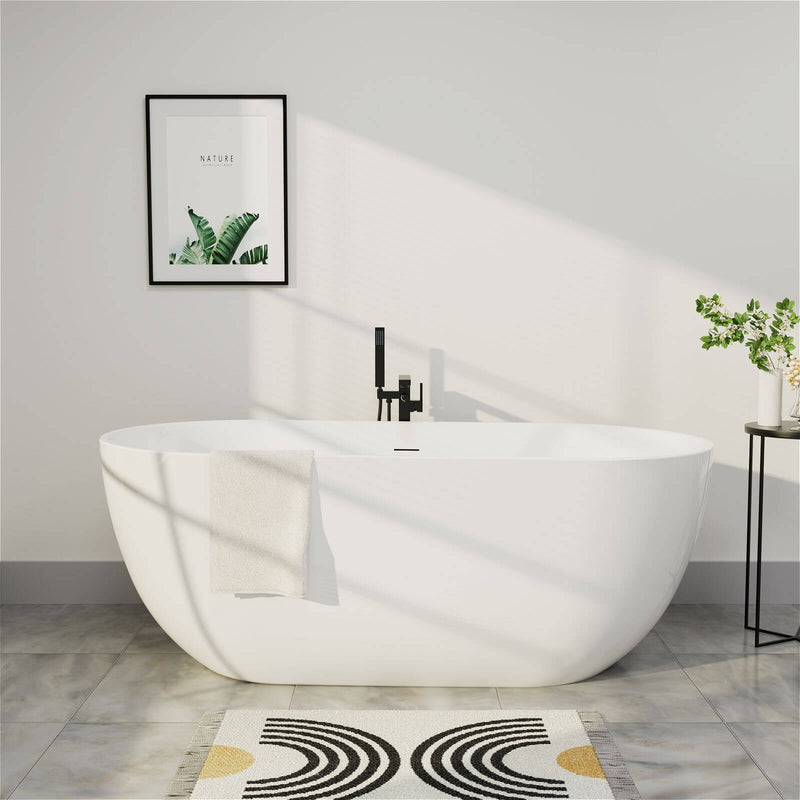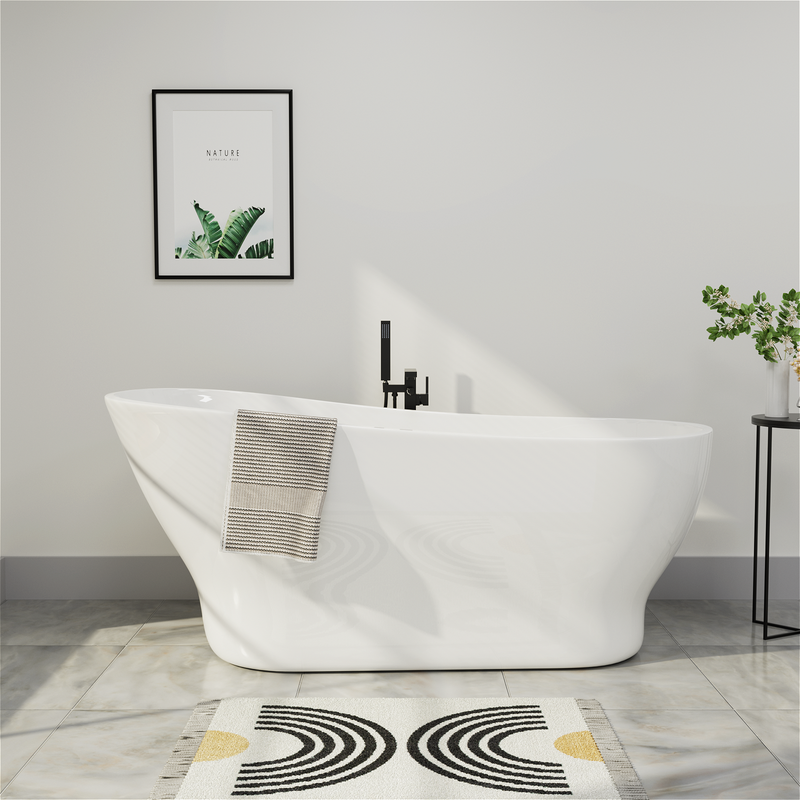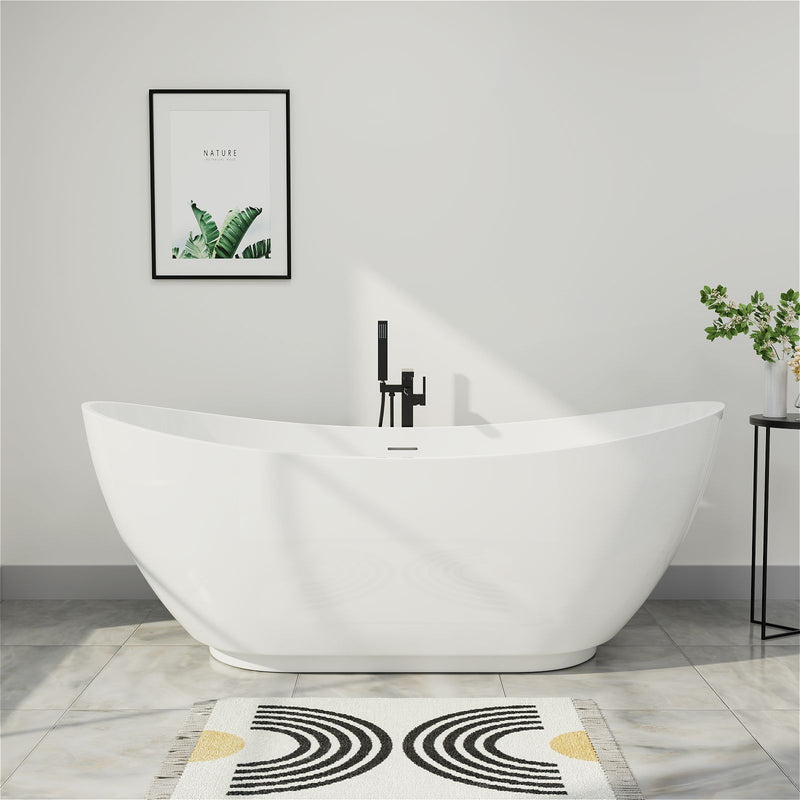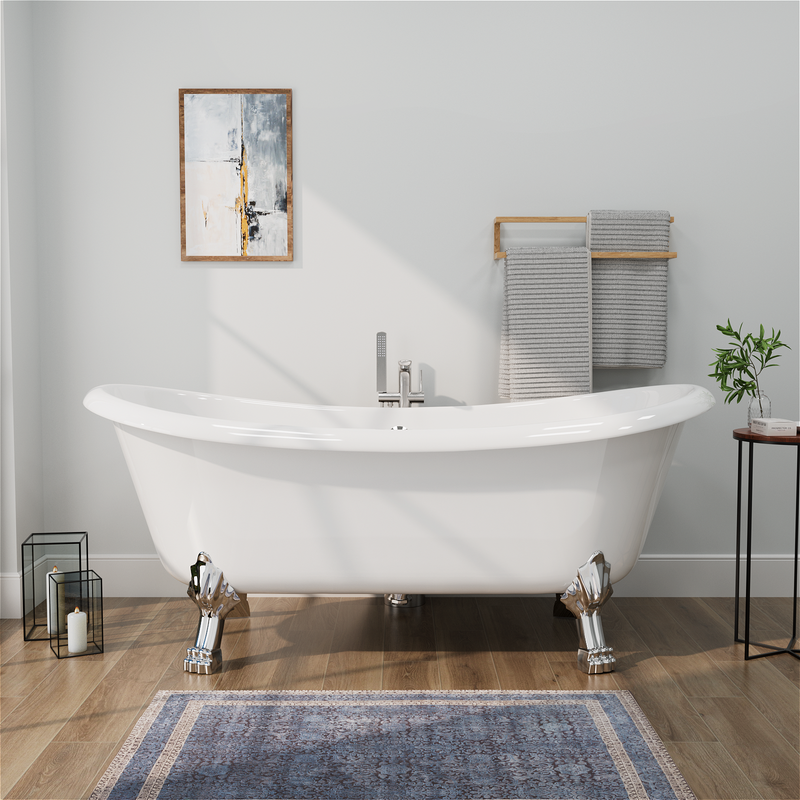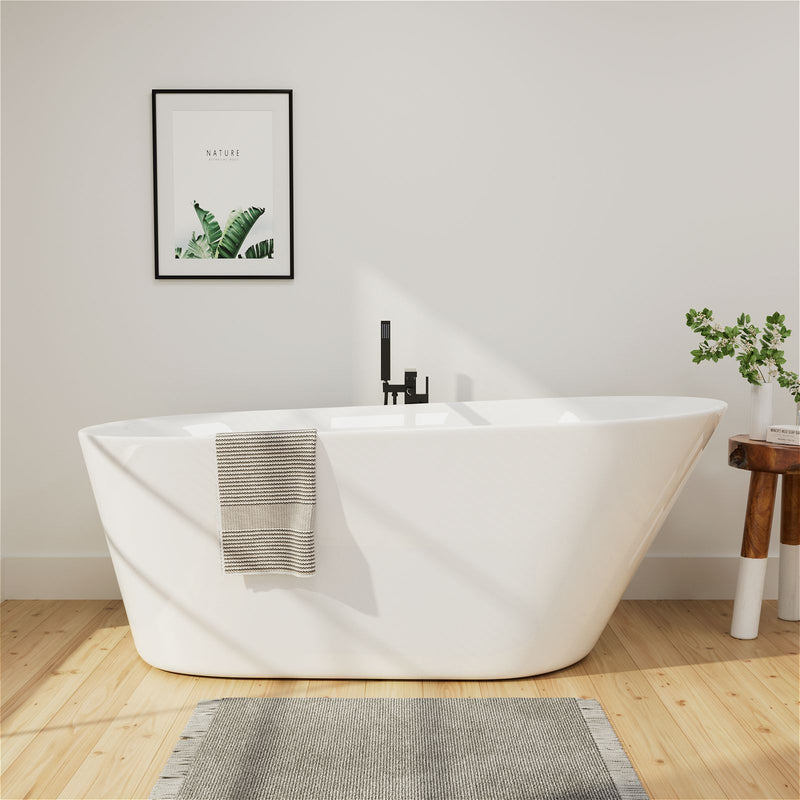Step into any American bathroom and you'll almost certainly see two main characters: the bathtub or the shower tray. They're more than just functional amenities; they impact daily comfort, morning efficiency, and the overall value of the home. When faced with a new home renovation or bathroom renovation, the question of "tub or shower tray?" becomes a difficult one for many American families.
This decision is more complex than it appears. It involves physical space constraints, budget flexibility, family differences, and even the home's future resale potential. The answer can be quite different in a city apartment where space is at a premium, a suburban home with elderly care needs, or a young family striving for efficiency.

This article will delve into the real-world comparisons between bathtubs and shower trays in three key areas: space utilization, overall cost, and adaptability to lifestyle habits. This will provide you with a clear and practical decision-making framework to help you create the ideal bathroom space that truly meets your family's needs.
The Battle for Space: Which One Fits Your Bathroom Layout Better?
Bathroom space varies greatly across American homes—from spacious master suites to compact guest bathrooms, space efficiency is paramount.
Footprint Analysis
Standard Freestanding Bathtub: A standard freestanding bathtub typically requires approximately 60-72 inches (length) x 30-36 inches (width). This doesn't include the necessary floor space around the bathtub (allow at least 12-18 inches). Clawfoot bathtubs may require more floor space due to their base design.
Built-in Bathtub: A built-in bathtub is mounted against the wall, with standard dimensions of approximately 60 inches x 32 inches. While slightly less space-efficient than a freestanding bathtub, it still requires a dedicated area.
Standard Rectangular Shower Tray: Available in a minimum of 32 inches x 32 inches, it provides basic shower functionality. More comfortable sizes are 36 inches x 36 inches or 42 inches x 42 inches.
Corner Shower Tray: Designed to utilize corner space, it often comes in either a 36-inch x 36-inch square or curved design. It's a space-saving solution for small bathrooms.
Pedestal-less Shower Areas: Use linear floor drains to achieve drainage through the ground slope, creating a more spacious feel. However, professional installation is required to ensure a precise slope and tight waterproofing.
Space Layout Flexibility
Bathtub Limitations: Their placement is relatively fixed, especially for built-in bathtubs, which must be against the wall and connected to plumbing. Relocating them often involves costly plumbing modifications.
Shower Pan Advantages: Significantly greater flexibility. Corner, straight-flow, and even custom-shaped shower pans are possible to create in irregular spaces. In modern open-plan designs, shower areas are often divided by glass partitions, visually expanding the sense of space.

Height and Vertical Space
Bathtubs: There are no specific height requirements; a standard height is sufficient.
Shower Enclosures: Consider the showerhead installation height (usually around 80 inches from the floor) and the ceiling height of the enclosed shower enclosure. If ceiling height is insufficient, a ceilingless, screened design is more suitable.
Golden Rules for Small Apartments and Single-Bathroom Homes
Single-bathroom homes: It is strongly recommended to retain at least one bathtub. This is driven by the general market perception that homes with bathtubs are more valuable and the rigid demand of families with young children (for bathing infants and toddlers).
Second bathrooms (guest/secondary bathrooms): These are ideal locations for shower trays. They free up space and improve efficiency, making them particularly suitable for guests or adults who need a quick shower.
Extremely small bathrooms (such as apartments): Corner shower trays are almost always the only viable option. Forgoing a bathtub frees up valuable space for a sink, toilet, or storage.
Cost Debunked: One-Time Investment vs. Long-Term Ownership Costs
When choosing between a bathtub and a shower tray, consider both current and potential future expenses.
Initial Purchase Cost (Product)
Basic Bathtubs: Standard drop-in acrylic bathtubs are relatively affordable and are a good entry-level option.
High-End Bathtubs: Freestanding cast iron bathtubs, whirlpool tubs, and bathtubs made from specialized materials (such as stone) can significantly increase in price.
Shower Trays (Bases): Basic acrylic shower tray bases are generally less expensive than basic bathtubs. Fiberglass reinforced plastic (FRP) shower trays offer the lowest price, but offer lower quality and durability.
Differences in Accessory Costs: Shower trays require the purchase of separate shower doors/screens and showerhead sets, which may cost more than the shower tray base itself. Bathtubs primarily require a bathtub faucet.
Installation Cost: A Comparison of Labor and Complexity
Standard Built-in Bathtub Installation: Relatively mature and standardized, installation costs are relatively stable. These primarily involve placement, plumbing connections, and perimeter sealing.
Freestanding Bathtub Installation: Clawfoot bathtubs, in particular, require high floor flatness and precise plumbing connections, resulting in generally higher installation costs. Floor load-bearing capacity also needs to be considered.
Shower Tray (Base) Installation: Basic shower tray installation may be simpler than bathtub installation. However, the core cost of a shower area lies in waterproofing. A qualified shower area requires rigorous waterproofing (walls, floors, and joints), especially for custom tiled shower areas, which can incur significant labor costs.
Pedestal-less Shower Areas: Professional masons meticulously grade the surface and use a waterproof membrane system. Material and labor costs are significantly higher than those for standard shower tray or bathtub installation.
Upgrade Cost: Relocating a bathtub to a shower area, or vice versa, involves demolition, structural changes, plumbing relocation, and waterproofing reconstruction, making it the most expensive option.
Long-Term Use and Maintenance Costs
Water Usage: Showers are generally more water-efficient than baths, especially when using a water-saving showerhead. A full bath consumes significantly more water than a 5-10 minute shower. In areas with high water rates, showers are more economical in the long run.
Energy Consumption (Hot Water): The energy cost of heating a bathtub is significantly higher than that of heating shower water. This is especially noticeable in winter.

Cleaning and Maintenance
Bathtubs: The large interior surface requires regular cleaning to prevent soap scum and water stains. Acrylic surfaces are easily scratched, while cast iron enamel surfaces are sensitive to hard objects.
Shower Area: Glass doors and screens are prone to limescale and soap stains and require frequent cleaning. Tile grout is prone to mold and requires a specialized cleaner. The shower tray also requires cleaning.
Repair Costs
Bathtubs: Common issues include surface scratches, glaze damage, and leaks (from the drain or pipe connections). Repairing scratches or surface damage is relatively simple; replacing severe damage is expensive.
Shower Areas: The core risk is leaks caused by waterproofing failure, which is costly to repair (removal and reinstallation is required). Damaged shower door hardware and aging seals are also common maintenance issues. Broken tiles require replacement and matching.
Lifestyle: Who Best Understands Your Daily Rhythm?
The bathroom is all about serving people. Your family composition, lifestyle, and personal preferences ultimately determine which choice brings you the greatest happiness.
Time Efficiency and Morning Rhythm
The Definitive Advantage of a Shower Tray: For families who rush through the morning, a shower is the perfect way to quickly wake up and cleanse efficiently. It can be done in minutes, significantly improving morning efficiency.
The "Slow Life" Attribute of a Bathtub: Bathing requires ample time (running the water and soaking), and it is a relaxing, stress-relieving ritual. It's perfect for evenings or weekends.
Relaxation, Stress Relief, and Wellness Needs
The Therapeutic Value of the Bathtub: Nothing is more soothing than a warm bath after a tiring day. Warm water helps relax muscles, relieve stress, and improve sleep. For those suffering from chronic pain, such as arthritis, warm soaks can offer physical therapy benefits. Adding bath salts, essential oils, or bubbles can enhance the experience.
The Revitalizing Effect of a Shower: Cold or alternating hot and cold showers can invigorate the mind and stimulate circulation. Powerful showerheads can massage shoulder and neck muscles (though not as deeply as a bathtub soak).
The Spa Experience: High-end massage bathtubs offer hydromassage, but are costly and complex to maintain. Versatile shower systems (overhead, side, and handheld) can also provide a rich sensory experience.
The Diverse Needs of the Family
Infants and Young Children: A bathtub is almost a necessity. Bathing babies and toddlers in a bathtub is safer, more convenient, and more enjoyable. Showers can be challenging and pose safety risks for young children.
School-Age Children and Teens: A gradual transition to a shower is possible, but many children still enjoy the playful space of a bathtub. A bathtub may be more practical for families with multiple children.
For Those with Limited Mobility and the Elderly: A shower tray (barrier-free design) is a safer option. A walk-in shower tray (with a low or no threshold), a built-in shower seat, non-slip flooring, and sturdy grab bars can significantly reduce the risk of slips. Bathtubs (especially those high up) can be difficult to enter and exit and pose a higher risk.
Walk-in Bathtubs: Designed specifically for seniors, these tubs have a sealed door and then fill with water. While they solve the entry and exit problem, they can feel cramped, are expensive, and take longer to drain.
For Multi-generational Households: The needs of children, adults, and the elderly need to be accommodated. A separate bathtub and shower (combination) in the master bathroom is ideal, while a shower tray can be preferred in secondary bathrooms.
Home Values and Market Preferences
Mainstream Market Perception: In most parts of the United States, homes with at least one bathtub are generally considered more complete and attractive, especially for young families. Removing all bathtubs may narrow the potential buyer pool.

Exceptions:
In the High-end Market or Larger Homes: A luxurious freestanding bathtub and spacious shower in the master bedroom suite is standard.
Small Apartments/Apartments/Pure Investment Properties: Shower trays are more practical, and full shower configurations are sometimes acceptable.
For Homes in Senior Housing Complexes: Accessible shower trays are a must-have and a selling point.
Trend Shifts: With the prevalence of smaller apartments and an aging population, demand for high-quality shower spaces is rising. However, as a symbol of "comfortable living," the bathtub's dominant position is unlikely to be completely replaced in the short term.
Integration: Break the "Either-or" Mindset
Who says you have to choose between two? If space and budget permit, a bathtub + shower combination offers ultimate flexibility and comfort, meeting all family needs.
Combined Bathtub and Shower
The most common solution: Install a showerhead and shower curtain/glass screen above the built-in bathtub. This saves space and is relatively low-cost.
Disadvantages: Shower space can be cramped (especially if the tub is not wide enough); entering and exiting the tub can still be inconvenient for elderly and children; and special attention should be paid to the anti-slip properties of the bathtub wall as a shower floor.
Separate Shower + Separate Bathtub
Ideal Configuration: In a spacious master bathroom, separate shower and bathtub areas are created (usually separated by a glass partition).
Advantages: Enjoy both a bath and a spacious shower, without interfering with each other; optimal safety, comfort, and overall experience.
Cost and Space Requirements: Requires the largest possible space and budget.
Smart Bathroom Integration Trends
Multi-functional Shower Systems: Provide a near-spa experience (with multiple jet modes, ambient lighting, and steam functions), partially replacing the relaxing functions of a bathtub.
Smart Bathtubs: Integrated massage, heating, thermal insulation, spa lighting, and sound systems enhance the bathing experience and efficiency.
Conclusion: Make the Smart Choice for Your Family
There's no one-size-fits-all answer to the bathtub vs. shower tray debate. It's a decision that requires a comprehensive balance of space, cost, and lifestyle.
Space is a Hard Constraint: Measure your bathroom precisely and prioritize feasibility. For small spaces, compromise with a shower tray; for larger spaces, pursue a combination of configurations.
Consider Costs Holistically: Look beyond the product price tag and factor in the long-term bills for installation, utilities, and maintenance. Waterproofing is a significant investment in the shower area and shouldn't be overlooked.
Habits Determine Happiness: Carefully examine your family's structure, age groups, lifestyles, and core needs. Do you prioritize morning efficiency or evening relaxation? Do you have young children or elderly individuals with mobility issues?
Value Requires a Long-term Perspective: Consider your living plans for the next few years and potential resale demand. Keeping a bathtub is often a safer market strategy.
Ultimately, the best choice for your home is the one that best serves the current residents' daily lives, enhances convenience and comfort, and harmonizes with the overall design of the home. Whether it's the immersive relaxation of a bathtub or the efficiency and convenience of a shower tray, the core goal is to create a bathroom space that makes your family feel comfortable, safe, and happy.

